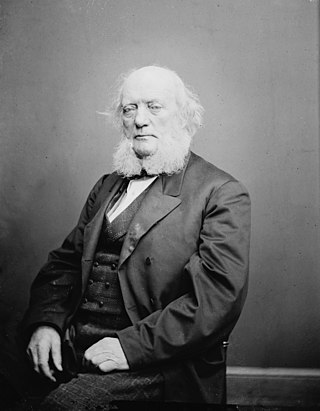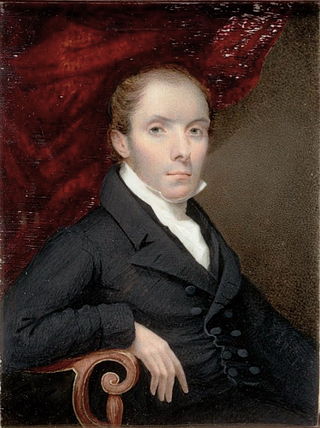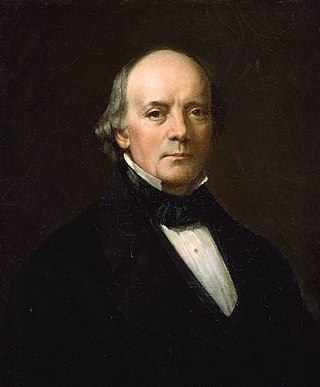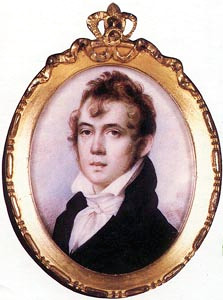
Richard Morrell Staigg (7 September 1817 Leeds, England - 11 October 1881 Newport, Rhode Island) or R.M. Staigg was a portrait painter in Boston, Massachusetts, in the 19th century. [1] [2]

Richard Morrell Staigg (7 September 1817 Leeds, England - 11 October 1881 Newport, Rhode Island) or R.M. Staigg was a portrait painter in Boston, Massachusetts, in the 19th century. [1] [2]
When he was about thirteen years of age he was placed in an architect's office, and he subsequently received a few weeks' instruction in portrait painting. In 1831 he came to the United States with his father, and four years later he settled with the family in Newport. In his artistic efforts he met with encouragement and advice from Washington Allston, and soon devoted himself entirely to miniature painting.
In Boston he kept a studio in Amory Hall. [3] He belonged to the Boston Artists' Association. He was a regular exhibitor at the National Academy of Design, New York City, of which he was elected an associate in 1856, and an academician in 1861. He visited Europe 1867–1869, and again 1872–1874. The last twenty years of his life were devoted to painting life-size portraits in oil, as well as genre pieces and landscapes.
Among his portraits are those of Washington Allston, Edward Everett, Daniel Webster, William H. Prescott, and others. Some of his miniatures were exhibited at the Royal Academy, and received warm praise. Among his works in oil are portraits of himself, of Russell Sturgis and George H. Calvert, and the "Crossing Sweeper," "The Sailor's Grave" (1862), and "Cat's Cradle" (1863).

Emanuel Gottlieb Leutze was a German-born American history painter best known for his 1851 painting Washington Crossing the Delaware. He is associated with the Düsseldorf school of painting.

Gilbert Charles Stuart was an American painter from Rhode Island Colony who is widely considered one of America's foremost portraitists. His best-known work is an unfinished portrait of George Washington, begun in 1796, which is sometimes referred to as the Athenaeum Portrait. Stuart retained the portrait and used it to paint scores of copies that were commissioned by patrons in America and abroad. The image of George Washington featured in the painting has appeared on the United States one-dollar bill for more than a century and on various postage stamps of the 19th century and early 20th century.

John Trumbull was an American artist of the early independence period, notable for his historical paintings of the American Revolutionary War, of which he was a veteran. He has been called the "Painter of the Revolution".

Washington Allston was an American painter and poet, born in Waccamaw Parish, South Carolina. Allston pioneered America's Romantic movement of landscape painting. He was well known during his lifetime for his experiments with dramatic subject matter and his bold use of light and atmospheric color. While his early artworks concentrate on grandiose and spectacular aspects of nature, his later pieces represent a more subjective and visionary approach.

William Morris Hunt was an American painter.

Chester Harding was an American portrait painter known for his paintings of prominent figures in the United States and England.

Robert Feke was an American portrait painter born in Oyster Bay, New York. According to art historian Richard Saunders, "Feke’s impact on the development of Colonial painting was substantial, and his pictures set a new standard by which the work of the next generation of aspiring Colonial artists was judged." In total, about 60 paintings by Feke survive, twelve of which are signed and dated.

James Peale was an American painter, best known for his miniature and still life paintings, and a younger brother of noted painter Charles Willson Peale.

The Massachusetts Historical Society (MHS) is a major historical archive specializing in early American, Massachusetts, and New England history. The Massachusetts Historical Society was established in 1791 and is located at 1154 Boylston Street in Boston, Massachusetts, and is the oldest historical society in the United States.

Sarah Goodridge was an American painter who specialized in portrait miniatures. She was the older sister of Elizabeth Goodridge, also an American miniaturist.

Anna Claypoole Peale was an American painter who specialized in portrait miniatures on ivory and still lifes. She and her sister, Sarah Miriam Peale, were the first women elected academicians of the Pennsylvania Academy of the Fine Arts.

Thomas Edwards (1795–1869) was an artist in 19th-century Boston, Massachusetts, specializing in portraits. Born in London and trained at the Royal Academy, he worked in Boston in the 1820s-1850s, and in Worcester in the 1860s.

Harding's Gallery in Boston, Massachusetts, exhibited works by European and American artists in the 1830s-1840s. The building on School Street also housed a newspaper press; the Mercantile Library Association; the Boston Artists' Association; and artists' studios. The building's name derived from painter Chester Harding, who kept his studio there.

Williams & Everett (est.1855) in Boston, Massachusetts, was an art dealership run by Henry Dudley Williams and William Everett. The firm sold original artworks by American and European artists, as well as "photographs and carbon-pictures of eminent persons, noted places, and famous paintings." It also continued the mirror and picture frame business that had been established earlier by the Doggett brothers.

Anson Dickinson was an American painter of miniature portraits who achieved fame during his lifetime, producing a very large number of works, but who is now largely forgotten.
Charles Fraser, was an American artist best known for his miniatures of prominent American figures.
Jane Stuart was an American painter, best known for her miniature paintings and portraits, particularly those made of George Washington. She worked on and later copied portraits made by her father, Gilbert Stuart, and created her own portraits. In the early 19th century, she assumed the responsibility of supporting her family after her father's death. She first worked in Boston, but later moved to Newport, Rhode Island, where she was the first woman who painted portraits. In 2011, she was inducted into the Rhode Island Heritage Hall of Fame.

Arthur James Stark was an English painter and a member of the Norwich School of painters.
Samuel King was an American painter of miniature portraits and instructor.

James Bowman was an American itinerant artist and portrait painter. He was born in Allegheny County, Pennsylvania near Pittsburgh. Sometime between 1813 and 1815, James Bowman went to Chillicothe, Ohio, to learn to be a carpenter. There he met the itinerant painter Mr. J. T. Turner who taught him the rudiments of portrait painting. He gained considerable success when he started out professionally, painting in Pittsburgh and other communities in the early 1820s. He traveled to Philadelphia to learn from the masters there, but as a beginning artist could not make a living in that more cosmopolitan and competitive environment and became an itinerant portrait painter instead.